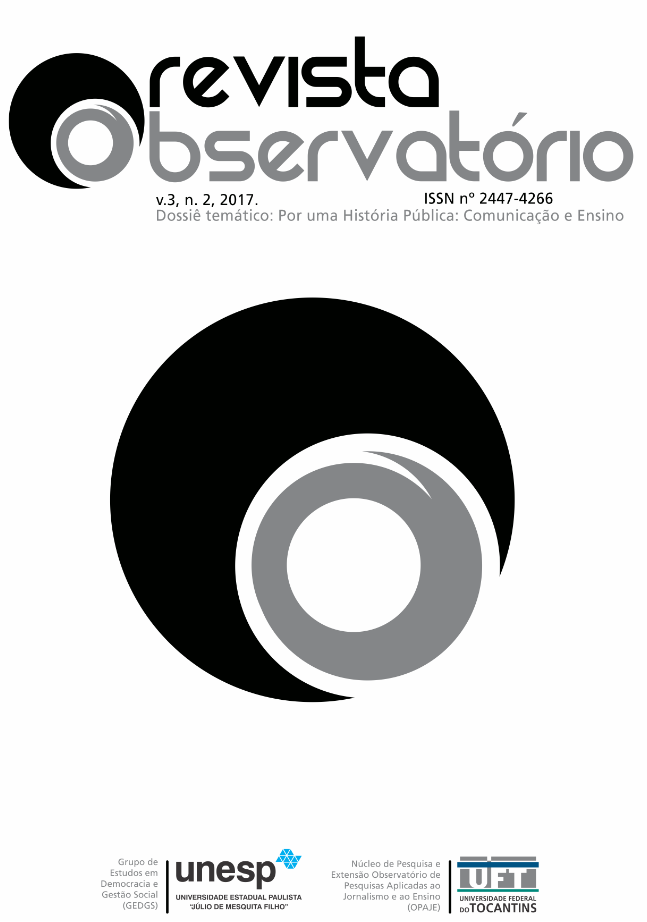A PUBLICIDADE NA TELEVISÃO E A OBESIDADE INFANTIL: Características e revisão de literatura no contexto brasileiro
DOI:
https://doi.org/10.20873/uft.2447-4266.2017v3n2p503Palavras-chave:
Obesidade infantil, televisão, publicidade infantilResumo
A obesidade infantil é um problema social no Brasil e em todo mundo, com sérios riscos à saúde das pessoas e com gastos superlativos disponibilizados pelo poder público no tratamento de doenças oriundas da obesidade infantil, com agravamento na idade adulta. Parte da culpa pela má alimentação das crianças e, consequente, do excesso de peso, costuma ser atribuída à publicidade de alimentos, por induzi-las à ingestão de produtos altamente calóricos. Este estudo propõe o aprofundamento da discussão da relação da publicidade, veiculada na televisão, com a obesidade infantil, no contexto brasileiro. Selecionou-se a plataforma CAPES como fonte principal para a pesquisa, por se tratar da plataforma com maior representatividade de pesquisadores brasileiros. Por fim, à luz da revisão da literatura, percebe-se a desmistificação da publicidade como responsável direta pela obesidade infantil. Nota-se também o interesse emergente, sobre a midiatização como uma questão cultural.
Downloads
Referências
ALMEIDA, S. S.; NASCIMENTO, P. C.; QUAIOTI, T. C. B. Quantidade e qualidade de produtos alimentícios anunciados na televisão brasileira. Revista Saúde Pública; 36(3):353-5, 2002.
BAADER, C. Alimentação-diversão-nutrição: Por uma Nova Estética no Contexto da Midiatização Publicitária de Alimentos Infantis.COMUNICON, 2015. Disponívelem: <http://bit.ly/1SOtDBY>.
BOYLAND, E. J.; HALFORD, J. C.G. Television advertising and branding. Effects on eating behavior and food preferences in children. Revista Apetite, v. 62, 1 de março de 2013, p. 236-241, 2013.
CASTONGUAY, J.; KUNKEL, D.; WRIGHT, P.; DUFF, C. Healthy characters? An investigation of marketing practices in children’s food advertising. Journal of Nutrition Educational and Behavior, v. 45, cap. 6, pp. 571-577, 2013.
CLARO, J. A. C. D. S.; MENCONI, A. T. L.; LORETO, J. R. Consumo infantil: o telefone celular e a criança. Revista Eletrônica do Mestrado Profissional em Administração da Universidade Potiguar, São Paulo, v. 5, n. 1, p. 21-32, 2012.
CARNEIRO, V. G. A influência da mídia na obesidade de crianças e adolescentes. UNAERP - Universidade de Ribeirão Preto, 2007. Disponível em: < http://bit.ly/1SpNPcW>.
HJAVARD, S. Midiatização: teorizando a mídia como agente de mudança social e cultural. Revista Matrizes, São Paulo, v. 5, n. 2, 2011.
MAZZOCANTE, R. P.; MORAES, J. F. V. N.; CAMPBELL, C. S. G. Gastos públicos diretos com a obesidade e doenças associadas no Brasil. Revista de Ciências Médicas, v. 21, n. 1/6, 2012.
MENDES, T., CALADO, C., MACÊDO, D., CASSIMIRO, E., CALAZANS, J. Discurso das propagandas de alimentos voltadas para o público infantil. UNICAP- Universidade Católica de Pernambuco, Recife, 2012. Disponível em: < http://bit.ly/212rSSD>.
Leão, A. L. M. S.; Mello, S. C. B.; Freitas, G. K. A. (2011). Usos das marcas para o alinhamento do “eu” (footing) em interações sociais. Revista Brasileira de Gestão de Negócios, São Paulo, v. 13, n. 38, p. 61-79.
PETTIGREW, S.; TARABASHKINA, L.; ROBERTS, M.; QUESTER, P.; CHAPMAN, K.; MILLER, C. The effects of television and internet food advertising on parents and children. Revista Public Health Nutrition, v. 16, dezembro de 2013, cap. 12, 2013.
TRINDADE, E. Propaganda, Identidade e Discurso. Porto Alegre, 2012.
UEDA, M. H., VASCONCELOS, L. A. O efeito da publicidade de alimentos saudáveis e não saudáveis sobre as escolhas alimentares de crianças. Psicologia: Teoria e Pesquisa, Brasília, Jan-Mar, v. 30 n. 1, pp. 53-61, 2010.
YANOVSKI, S. Z.; YANOVSKI, J. A. Long-term drug treatment for obesity: a systematic and clinical review. JAMA: The Journal of the American Medical Association, v. 311, n. 1, pp. 74-86, 2014.
Publicado
Como Citar
Edição
Seção
Licença
[PT] Autores que publicam nesta revista concordam com os seguintes termos:
1. Autores mantém os direitos autorais e concedem à revista, sem pagamento, o direito de primeira publicação, com o trabalho simultaneamente licenciado sob a Creative Commons Attribution License (CC BY-NC 4.0), permitindo o compartilhamento do trabalho com reconhecimento da autoria do trabalho e publicação inicial nesta revista.
Leia todos os termos dos direitos autorais aqui.


